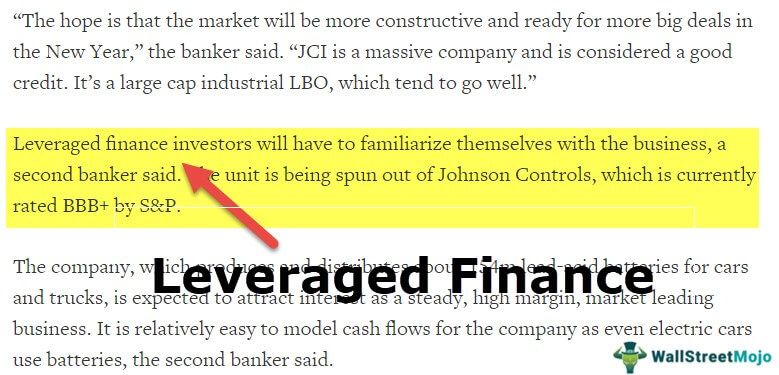Table Of Contents
Leveraged Finance Meaning
Leveraged finance refers to high-value debts offered to private equity firms by investment banking divisions. This division is referred to as the LevFin group. The loans are used for recapitalization, debt refinancing, leveraged buyouts, mergers, and acquisitions.
This financing is extended to the speculative-grade companies—with a credit rating of BB, BA, or even lower. For the banks, these are high-risk investments. At the same time, these debts are opportunities for yielding high interests.

Key Takeaways
- Leveraged Finance (LevFin) is a form of debt offered by institutional investors and banks.
- The borrowers are speculative-grade companies—private equity firms. The loans are availed for a specific purpose in lieu of high interests.
- The leveraged finance group (LFG) is a specialized investment banking division that extends LevFin.
- The LevFin group undertakes planning, structuring, and managing of debt financing for its clients.
- Leveraged financing is executed in three ways—leveraged loans, mezzanine finance, and high-yield bonds.
Leveraged Finance Explained
Leveraged finance groups are specialized departments of investment banking. The leveraged finance division (LFD) is responsible for providing overall debt financing solutions to clients. This involves planning, structuring, and managing of leveraged loans. Private Equity Firms and Leveraged Buyout Firms finance their customized projects aggressively—they use high leverage in their portfolio to enhance their returns. Investors use the cost of equity capital to measure the present value of a company.
Corporate funding of private equity firms witnesses higher-than-normal debt proportions (instead of equity or cash). This impacts the company's cash flow and net profit and may lead to lower Earnings Per Share EPS and dividends for the shareholders. However, to maximize the impact on Profit after Tax for a given change in operating profits (EBIT), higher fixed costs are used. Hence, using more Financial Leverage within a capital structure may enhance some financial ratios like return on equity.
The amount of financial leverage in business is usually a strategic choice. In contrast, an amount of operating leverage is driven by the prevalent business model in each industry. Hence, firms should limit the use of leverage in their capital structure—to limit risks. Or else stakeholders would fear potential solvency. However, some businesses use manufacturing plants, land, and equipment for the collateralization of borrowings; such firms use more financial leverage than their counterparts.
Leveraged Finance Products
The different kinds of leveraged financing used in business are as follows:
#1 – Institutional Term Loans and Leveraged Loans
Institutional investors offer term B loans to companies, and the borrowers repay according to the repayment schedule. The borrower repays a very little amount every year, and the remaining loan amount is to be repaid on maturity. A leveraged loan is allowed as debt—to individuals and corporations that have low credit scores. The lenders collaborate with leading banks to offer commercial loans and syndicated loans.
#2 – High Yield Bonds
These Junk Bonds are below investment grade, i.e., having a credit rating below BBB/Baa. The issuing companies cannot tap into bond markets and, therefore, raise capital through this mode of financing. As these bonds involve a risk of default, they are extended at a higher coupon rate. In addition, some of these bonds might come with negative covenants—no additional borrowing until the repayment of the previously issued bonds.
#3 – Mezzanine Finance
Mezzanine Financing is a hybrid method of raising capital for the company. In this method, the lender can transform debt into equity. It is a bridge between short-term financing and long-term financing—mostly used by small and medium-sized companies. It is very cost-efficient.
Leveraged Finance Example
Let us go through an example to understand the concept of Leveraged Finance:
Scenario 1: Buy a Company for $100 million in cash
Suppose there is an investment opportunity to buy a company— for $100 million in cash. Analysis shows a resale valuation of $200 million after 5 years. The reseller can potentially avail a handsome return of 2x in 5 years.
Based on calculations, the Internal Rate of Return for scenario 1 is 15%.

Scenario 2: - 50% cash and 50% Debt Financing
Let us assume a change; the deal is now financed with 50% cash and 50% debt. The selling price is still $200 million.
- We also assume that the total payment of $5 million is made each year. This five million includes both the interest payment and the principal repayment.
- At the end of the five years, the remaining debt is $39 million.
- If the company is sold at $200 million, the reseller avails a net amount of $200 million – $39 million = $161 million.
- In this case, the IRR is 21% (much higher than an all-cash deal)

Predictable cash flows provide estimates on returns and are hence, very crucial for analyzing leveraged finance.
Advantages and Disadvantages
Leveraged finance is a high-risk, high-return debt, and it has several benefits for both investors and borrowers. Given below are the various advantages of LevFin:
- Through LevFin, speculative-grade companies can easily avail high capital investment. Without this provision, firms with low credit ratings struggle to get funds.
- These investments provide higher than normal returns to banks and investors—due to increased default risk.
- A LevFin can be used for high-value projects—mergers, acquisitions, leveraged buyouts, debt refinancing, and recapitalizations.
LevFin has the following limitations:
- There is considerable financial risk; speculative-grade borrowers have a BB or BA credit rating.
- It leads to a higher debt-to-equity ratio. Higher debts mean more financial obligations—fixed interest and principal repayment. The borrowing firm must fulfill obligations irrespective of profits, or else they become insolvent.
- LevFin brings down the liquidity of the company. This raises questions about the firm’s long-term solvency.
- The impact of macroeconomic factors like recession or depression impacts leveraged firms more seriously—increasing the chances of default.
